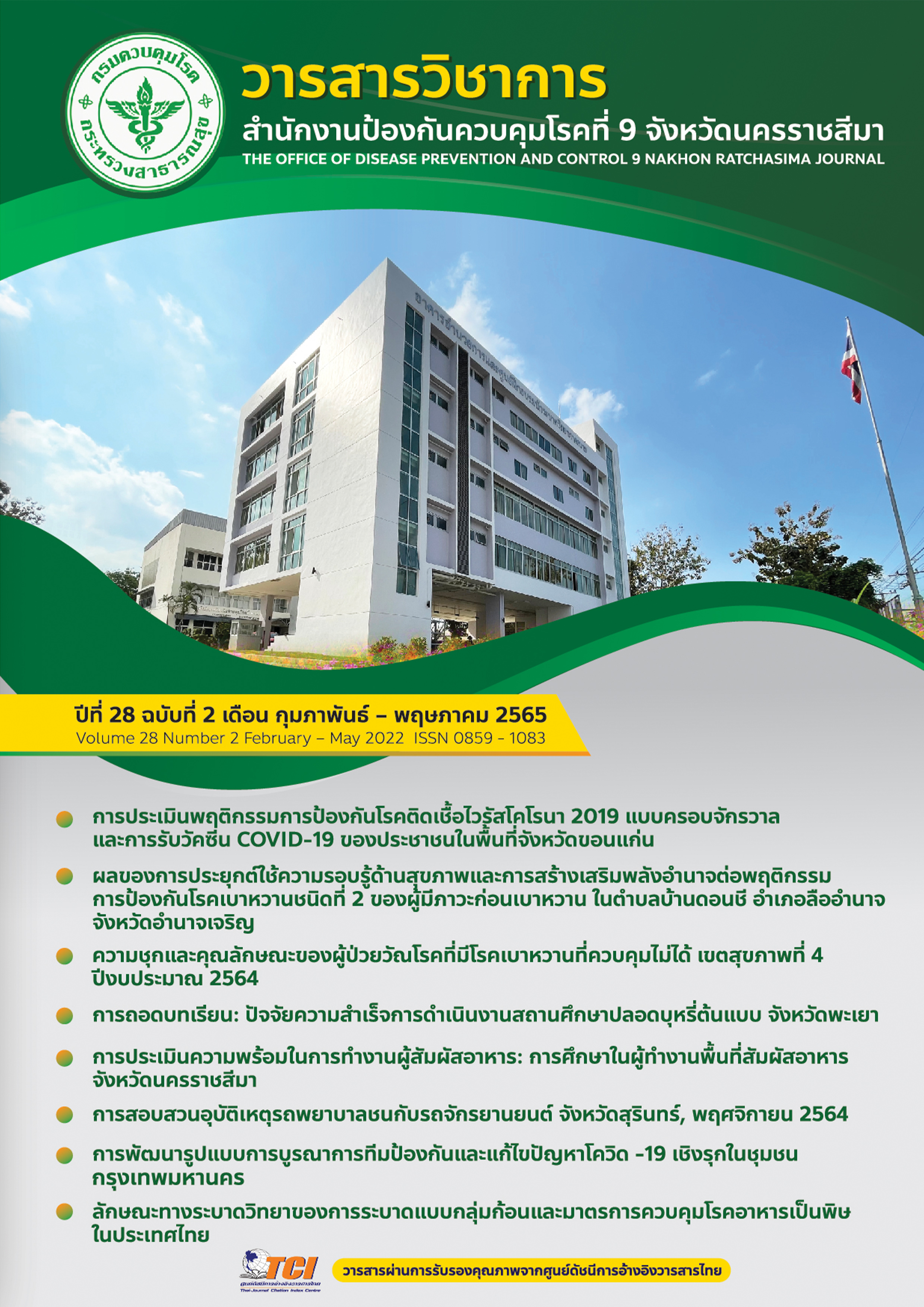Epidemiological Characteristics of Cluster Epidemic and Control Measures of Food Poisoning Diseases in Thailand
Keywords:
Food Poisoning Diseases, Cluster Epidemic, Food SanitationAbstract
This research study was a descriptive study (Retrospective data collection), Using secondary data from the Department of Disease Control, Ministry of Public Health, Called Event-based Surveillance. The study is objectives are to describe the Epidemiological characteristics of Cluster Epidemic, also Food Poisoning diseases control measurement in Thailand, within 2013 - 2021. The distribution of Cluster Food Poisoning diseases shows that there are 472 cluster Food Poisoning Epidemic events, they have 31,684 patients, 58.37% of all patients were gender unspecified, 97.03% were Thai citizens, 62.13% was Outpatient department treatment. Most Food Poisoning diseases event came from food, drinking water, consuming water, and ice, equal to 55.44%, unidentifiable pathogens was 35.69 which is the largest part compared to identifiable pathogens For Cluster Food Poisoning diseases control measurements in the top 3 were 1. Hygiene education to patients, food providers, and accomplices by public health officers (34.19%). 2. Active survey to search for additional patients (19.70%). Lastly, 3.Control food, drinking water, consume water and ice (16.80%). However, sanitation measurement for toilets is likely to be the least measurement that was used for controlling Food Poisoning diseases (3.73%). In summary, giving people education and awareness about self-protection from Food Poisoning diseases, also place importance on the measurement of food and environmental sanitation and relevant.
References
World Health Organization. Estimating the burden of foodborne diseases. [online]. 2564 [เข้าถึงเมื่อ 2565 มีนาคม 18]. เข้าถึงได้จาก / https://www.who.int/activities/estimating-the- burden-of-foodborne-diseases.
กองระบาดวิทยา กรมควบคุมโรค. สรุปรายงานการเฝ้าระวังโรคจากการประกอบอาชีพและสิ่งแวดล้อม โรคไม่ติดต่อ และโรคจากการป้องกันการบาดเจ็บ ปี 2562; 2562.
กองโรคติดต่อทั่วไป กรมควบคุมโรค. แนวทางสำหรับครู เรื่องการป้องกันควบคุมโรคอาหารเป็นพิษในโรงเรียน, กรุงเทพ: โรงพิมพ์องค์การสงเคราะห์ทหารผ่านศึกในพระบรมราชูปถัมภ์; 2559.
กองระบาดวิทยา กรมควบคุมโรค. นิยามโรคและแนวทางการรายงานโรคติดต่ออันตรายและโรคติดต่อที่ต้องเฝ้าระวัง ตามพระราชบัญญัติโรคติดต่อ พ.ศ. 2558, กรุงเทพ: หจก.แคนนา กราฟฟิค; 2563.
กองระบาดวิทยา กรมควบคุมโรค. สถานการณ์โรคอาหารเป็นพิษ รายงานโรคในระบบเฝ้าระวัง 506 ปี 2563; 2563.
Dewey-Mattia D, Manikonda K, Hall AJ, Wise ME, Crowe SJ. Surveillance for Foodborne Disease Outbreaks - United States, 2009-2015. MMWR Surveill Summ 2018; 67(10): 1-11.
Much P, Pichler J, Kasper SS, Allerberger F. Foodborne outbreaks, Austria 2007. Wiener klinische Wochenschrift 2009; 121(3-4): 77-85.
Meftahuddin T. Review of the trends and causes of food borne outbreaks in Malaysia from 1988 to 1997. Med J Malaysia 2002; 57(1): 70-9.
Yu CP, Chou YC, Wu DC, Cheng CG, Cheng CA. Surveillance of foodborne diseases in Taiwan: A retrospective study. Medicine (Baltimore) 2021; 100(5): e24424.
กุลจิรา เพ็ชรกุล และกรรณิการ์ ณ ลำปาง. ปัจจัยที่มีผลต่อการปฏิบัติในการป้องกันการติดเชื้อสเตรปโตคอกคัส ซูอิสของประชาชนจังหวัดเชียงใหม่. วารสารสาธารณสุขล้านนา 2563; 16(1): 13-23.
Faour-Klingbeil D, E CDT. Prevention and Control of Foodborne Diseases in Middle-East North African Countries: Review of National Control Systems. Int J Environ Res Public Health 2019; 17(1): 1.
Goh KT. Surveillance of food poisoning and other food-borne diseases in Singapore. Ann Acad Med Singap 1987; 16(4): 577-82.
ประกาศกระทรวงสาธารณสุข เรื่อง ชื่อและอาการสำคัญของโรคติดต่อที่ต้องเฝ้าระวัง พ.ศ. 2562 [ออนไลน์]. 2562 [เข้าถึงเมื่อ 2565 มีนาคม 15]. เข้าถึงได้จาก https://ddc.moph.go.th/uploads/files/9320200128083444.PDF.
กรมควบคุมโรค. โรคอาหารเป็นพิษ 2565[ออนไลน์].2565 [เข้าถึงเมื่อ 2565 มีนาคม 15] เข้าถึงได้จาก https://ddc.moph.go.th/disease_detail.php?d=10.

Downloads
Published
How to Cite
Issue
Section
License
Copyright (c) 2022 The office of disease prevention and control 9th Nakhon Ratchasima

This work is licensed under a Creative Commons Attribution-NonCommercial-NoDerivatives 4.0 International License.
บทความที่ลงพิมพ์ในวารสารวิชาการสำนักงานป้องกันควบคุมโรคที่ 9 จังหวัดนครราชสีมา ถือว่าเป็น
ลิขสิทธิ์ สำนักงานป้องกันควบคุมโรคที่ 9 จังหวัดนครราชสีมา



